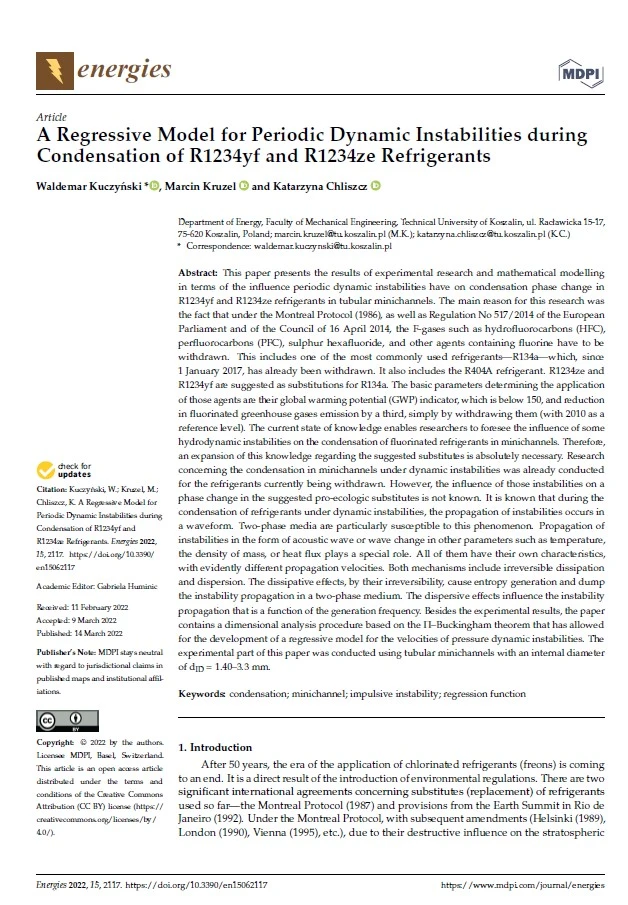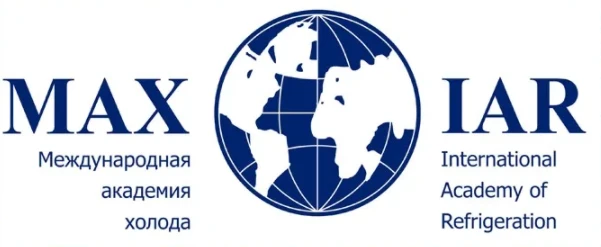Автор: Waldemar Kuczynski, Marcin Kruzel, Katarzyna Chliszcz
Год: 2022Язык: АнглийскийТип: Статьи
This paper presents the results of experimental research and mathematical modelling in terms of the influence periodic dynamic instabilities have on condensation phase change in R1234yf and R1234ze refrigerants in tubular minichannels. The main reason for this research was the fact that under the Montreal Protocol (1986), as well as Regulation No 517/2014 of the European Parliament and of the Council of 16 April 2014, the F-gases such as hydrofluorocarbons (HFC), perfluorocarbons (PFC), sulphur hexafluoride, and other agents containing fluorine have to be withdrawn. This includes one of the most commonly used refrigerants—R134a—which, since 1 January 2017, has already been withdrawn. It also includes the R404A refrigerant. R1234ze and R1234yf are suggested as substitutions for R134a. The basic parameters determining the application of those agents are their global warming potential (GWP) indicator, which is below 150, and reduction in fluorinated greenhouse gases emission by a third, simply by withdrawing them (with 2010 as a reference level). The current state of knowledge enables researchers to foresee the influence of some hydrodynamic instabilities on the condensation of fluorinated refrigerants in minichannels. Therefore, an expansion of this knowledge regarding the suggested substitutes is absolutely necessary. Research
concerning the condensation in minichannels under dynamic instabilities was already conducted for the refrigerants currently being withdrawn. However, the influence of those instabilities on a phase change in the suggested pro-ecologic substitutes is not known. It is known that during the condensation of refrigerants under dynamic instabilities, the propagation of instabilities occurs in a waveform. Two-phase media are particularly susceptible to this phenomenon. Propagation of instabilities in the form of acoustic wave or wave change in other parameters such as temperature, the density of mass, or heat flux plays a special role. All of them have their own characteristics, with evidently different propagation velocities. Both mechanisms include irreversible dissipation and dispersion. The dissipative effects, by their irreversibility, cause entropy generation and dump
the instability propagation in a two-phase medium. The dispersive effects influence the instability propagation that is a function of the generation frequency. Besides the experimental results, the paper contains a dimensional analysis procedure based on the P–Buckingham theorem that has allowed for the development of a regressive model for the velocities of pressure dynamic instabilities. The experimental part of this paper was conducted using tubular minichannels with an internal diameter of dID = 1.40–3.3 mm.
concerning the condensation in minichannels under dynamic instabilities was already conducted for the refrigerants currently being withdrawn. However, the influence of those instabilities on a phase change in the suggested pro-ecologic substitutes is not known. It is known that during the condensation of refrigerants under dynamic instabilities, the propagation of instabilities occurs in a waveform. Two-phase media are particularly susceptible to this phenomenon. Propagation of instabilities in the form of acoustic wave or wave change in other parameters such as temperature, the density of mass, or heat flux plays a special role. All of them have their own characteristics, with evidently different propagation velocities. Both mechanisms include irreversible dissipation and dispersion. The dissipative effects, by their irreversibility, cause entropy generation and dump
the instability propagation in a two-phase medium. The dispersive effects influence the instability propagation that is a function of the generation frequency. Besides the experimental results, the paper contains a dimensional analysis procedure based on the P–Buckingham theorem that has allowed for the development of a regressive model for the velocities of pressure dynamic instabilities. The experimental part of this paper was conducted using tubular minichannels with an internal diameter of dID = 1.40–3.3 mm.


















Комментарии
Войдите или зарегистрируйтесь, чтобы оставить комментарий